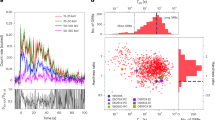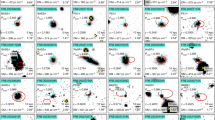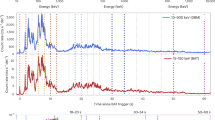Abstract
When massive stars exhaust their fuel, they collapse and often produce the extraordinarily bright explosions known as core-collapse supernovae. On occasion, this stellar collapse also powers an even more brilliant relativistic explosion known as a long-duration γ-ray burst. One would then expect that these long γ-ray bursts and core-collapse supernovae should be found in similar galactic environments. Here we show that this expectation is wrong. We find that the γ-ray bursts are far more concentrated in the very brightest regions of their host galaxies than are the core-collapse supernovae. Furthermore, the host galaxies of the long γ-ray bursts are significantly fainter and more irregular than the hosts of the core-collapse supernovae. Together these results suggest that long-duration γ-ray bursts are associated with the most extremely massive stars and may be restricted to galaxies of limited chemical evolution. Our results directly imply that long γ-ray bursts are relatively rare in galaxies such as our own Milky Way.
This is a preview of subscription content, access via your institution
Access options
Subscribe to this journal
Receive 51 print issues and online access
We are sorry, but there is no personal subscription option available for your country.
Buy this article
- Purchase on SpringerLink
- Instant access to full article PDF
Prices may be subject to local taxes which are calculated during checkout




Similar content being viewed by others
References
Riess, A. G. et al. Observational evidence from supernovae for an accelerating universe and a cosmological constant. Astron. J. 116, 1009–1038 (1998)
Perlmutter, S. et al. Measurements of Ω and Λ from 42 high-redshift supernovae. Astrophys. J. 517, 565–586 (1999)
Branch, D., Livio, M., Yungelson, L. R., Boffi, F. R. & Baron, E. In search of the progenitors of type IA supernovae. Publ. Astron. Soc. Pacif. 107, 1019–1028 (1995)
Heger, A., Fryer, C. L., Woosley, S. E., Langer, N. & Hartmann, D. H. How massive single stars end their life. Astrophys. J. 591, 288–300 (2003)
Kouveliotou, C. et al. Identification of two classes of gamma-ray bursts. Astrophys. J. 413, 101–104 (1993)
Gehrels, N. et al. A short γ-ray burst apparently associated with an elliptical galaxy at redshift z = 0.225. Nature 437, 851–854 (2005)
Prochaska, J. X. et al. The galaxy hosts and large-scale environments of short-hard γ-ray bursts. Astrophys. J. Lett. (in the press): preprint at http://arxiv.org/astro-ph/0510022 (2005)
Fruchter, A. S. et al. HST and Palomar imaging of GRB 990123: Implications for the nature of gamma-ray bursts and their hosts. Astrophys. J. 519, 13–16 (1999)
Sokolov, V. V. et al. Host galaxies of gamma-ray bursts: Spectral energy distributions and internal extinction. Astron. Astrophys. 372, 438–455 (2001)
Le Floc'h, E. et al. Are the hosts of gamma-ray bursts sub-luminous and blue galaxies? Astron. Astrophys. 400, 499–510 (2003)
Christensen, L., Hjorth, J. & Gorosabel, J. UV star-formation rates of GRB host galaxies. Astron. Astrophys. 425, 913–926 (2004)
Bloom, J. S., Djorgovski, S. G., Kulkarni, S. R. & Frail, D. A. The host galaxy of GRB 970508. Astrophys. J. 507, L25–L28 (1998)
Vreeswijk, P. M. et al. VLT spectroscopy of GRB 990510 and GRB 990712: Probing the faint and bright ends of the gamma-ray burst host galaxy population. Astrophys. J. 546, 672–680 (2001)
Bloom, J. S. et al. The unusual afterglow of the γ-ray burst of 26 March 1998 as evidence for a supernova connection. Nature 401, 453–456 (1999)
Galama, T. J. et al. Evidence for a supernova in reanalyzed optical and near-infrared images of GRB 970228. Astrophys. J. 536, 185–194 (2000)
Levan, A. et al. GRB 020410: A gamma-ray burst afterglow discovered by its supernova light. Astrophys. J. 624, 880–888 (2005)
Hjorth, J. et al. A very energetic supernova associated with the γ-ray burst of 29 March 2003. Nature 423, 847–850 (2003)
Stanek, K. Z. et al. Spectroscopic discovery of the supernova 2003dh associated with GRB 030329. Astrophys. J. 591, L17–L20 (2003)
Della Valle, M. et al. Evidence for supernova signatures in the spectrum of the late-time bump of the optical afterglow of GRB 021211. Astron. Astrophys. 406, L33–L37 (2003)
Malesani, D. et al. SN 2003lw and GRB 031203: A bright supernova for a faint gamma-ray burst. Astrophys. J. 609, L5–L8 (2004)
Zeh, A., Klose, S. & Hartmann, D. H. A systematic analysis of supernova light in gamma-ray burst afterglows. Astrophys. J. 609, 952–961 (2004)
Panaitescu, A. & Kumar, P. Fundamental physical parameters of collimated gamma-ray burst afterglows. Astrophys. J. 560, L49–L53 (2001)
Frail, D. A. et al. Beaming in gamma-ray bursts: Evidence for a standard energy reservoir. Astrophys. J. 562, L55–L58 (2001)
MacFadyen, A. I., Woosley, S. E. & Heger, A. Supernovae, jets, and collapsars. Astrophys. J. 550, 410–425 (2001)
van Dyk, S. D., Hamuy, M. & Filippenko, A. V. Supernovae and massive star formation regions. Astron. J. 111, 2017–2027 (1996)
van den Bergh, S., Li, W. & Filippenko, A. V. Classifications of the host galaxies of supernovae, Set III. Publ. Astron. Soc. Pacif. 117, 773–782 (2005)
Podsiadlowski, P., Mazzali, P. A., Nomoto, K., Lazzati, D. & Cappellaro, E. The rates of hypernovae and gamma-ray bursts: Implications for their progenitors. Astrophys. J. 607, L17–L20 (2004)
Bloom, J. S., Kulkarni, S. R. & Djorgovski, S. G. The observed offset distribution of gamma-ray bursts from their host galaxies: A robust clue to the nature of the progenitors. Astron. J. 123, 1111–1148 (2002)
Riess, A. G. et al. Identification of Type Ia supernovae at redshift 1.3 and beyond with the Advanced Camera for Surveys on the Hubble Space Telescope. Astrophys. J. 600, L163–L166 (2004)
Strolger, L. G. et al. The Hubble Higher z Supernova Search: Supernovae to z∼1.6 and constraints on Type Ia progenitor models. Astrophys. J. 613, 200–223 (2004)
Giavalisco, M. et al. The Great Observatories Origins Deep Survey: Initial results from optical and near-infrared imaging. Astrophys. J. 600, L93–L98 (2004)
Conselice, C. J. et al. Gamma-ray burst selected high redshift galaxies: Comparison to field galaxy populations to z∼3. Astrophys. J. 633, 29–40 (2005)
Schlegel, D. J., Finkbeiner, D. P. & Davis, M. Maps of dust infrared emission for use in estimation of reddening and cosmic microwave background radiation foregrounds. Astrophys. J. 500, 525–553 (1998)
Mirabal, N. et al. GRB 021004: A possible shell nebula around a Wolf-Rayet star gamma-ray burst progenitor. Astrophys. J. 595, 935–949 (2003)
Klose, S. et al. Probing a gamma-ray burst progenitor at a redshift of z = 2: A comprehensive observing campaign of the afterglow of GRB 030226. Astron. J. 128, 1942–1954 (2004)
Weidner, C. & Kroupa, P. in The Initial Mass Function 50 Years Later (eds Corbelli, E., Plla, F. & Zinnecker, H.) 125–186 (Springer, Dordrecht, 2005)
Bersier, D. et al. Evidence for a supernova associated with the x-ray flash 020903. Astrophys. J. (submitted)
Vreeswijk, P. M. et al. The host of GRB 030323 at z = 3.372: A very high column density DLA system with a low metallicity. Astron. Astrophys. 419, 927–940 (2004)
Prochaska, J. X. et al. The host galaxy of GRB 031203: Implications of its low metallicity, low redshift, and starburst nature. Astrophys. J. 611, 200–207 (2004)
Chen, H.-W., Prochaska, J. X., Bloom, J. S. & Thompson, I. B. Echelle spectroscopy of a GRB afterglow at z = 3.969: A new probe of the interstellar and intergalactic media in the young Universe. Astrophys. J. 634, L25–L28 (2005)
Kobulnicky, H. A. & Kewley, L. J. Metallicities of galaxies in the GOODS-North Field. Astrophys. J. 617, 240–261 (2004)
Figer, D. F., Najarro, F., Geballe, T. R., Blum, R. D. & Kudritzki, R. P. Massive stars in the SGR 1806-20 cluster. Astrophys. J. 622, L49–L52 (2005)
Crowther, P. A. & Hadfield, L. J. Reduced Wolf-Rayet line luminosities at low metallicity. Astron. Astrophys. 449, 711–722 (2006)
Woosley, S. & Heger, A. The progenitor stars of gamma-ray Bursts. Astrophys. J. 637, 914–921 (2005)
Yoon, S.-C. & Langer, N. Evolution of rapidly rotating metal-poor massive stars towards gamma-ray bursts. Astron. Astrophys. 443, 643–648 (2005)
Chapman, S. C., Blain, A. W., Smail, I. & Ivison, R. J. A redshift survey of the submillimeter galaxy population. Astrophys. J. 622, 772–796 (2005)
Fynbo, J. P. U. et al. On the Lyα emission from gamma-ray burst host galaxies: Evidence for low metallicities. Astron. Astrophys. 406, L63–L66 (2003)
Soderberg, A. M., Nakar, E., Kulkarni, S. R. & Berger, E. Late-time radio observations of 68 Type Ibc supernovae: Strong constraints on off-axis gamma-ray bursts. Astrophys. J. 638, 930–937 (2006)
van den Bergh, S. & Tammann, G. A. Galactic and extragalactic supernova rates. Annu. Rev. Astron. Astrophys. 29, 363–407 (1991)
Mannucci, F. et al. The supernova rate per unit mass. Astron. Astrophys. 433, 807–814 (2005)
Acknowledgements
Support for this research was provided by NASA through a grant from the Space Telescope Science Institute, which is operated by the Association of Universities for Research in Astronomy, Inc. Observations analysed in this work were taken by the NASA/ESA Hubble Space Telescope under programmes: 7785, 7863, 7966, 8189, 8588, 9074 and 9405 (Principal Investigator, A.S.F.); 7964, 8688, 9180 and 10135 (PI, S. R. Kulkarni); 8640 (PI, S.T.H.). We thank N. Panagia, N. Walborn and A. Soderberg for conversations; A. Filippenko and collaborators for early-time images of GRB 980326; and J. Bloom and collaborators for making public their early observations of GRB 020322.
Author information
Authors and Affiliations
Corresponding author
Ethics declarations
Competing interests
Reprints and permissions information is available at npg.nature.com/reprintsandpermissions. The authors declare no competing financial interests.
Supplementary information
Supplementary Notes
This file contains Supplementary Methods providing additional detail on the analysis. A Supplementary Notes section gives further detail on sample bias. Supplementary Tables provide details on the observations of the objects in the sample and Supplementary Figures show how the extent of the hosts as determined by our analysis and the placement of the objects on the hosts. (PDF 417 kb)
Rights and permissions
About this article
Cite this article
Fruchter, A., Levan, A., Strolger, L. et al. Long γ-ray bursts and core-collapse supernovae have different environments. Nature 441, 463–468 (2006). https://doi.org/10.1038/nature04787
Received:
Accepted:
Published:
Issue Date:
DOI: https://doi.org/10.1038/nature04787
This article is cited by
-
A wind environment and Lorentz factors of tens explain gamma-ray bursts X-ray plateau
Nature Communications (2022)
-
A peculiarly short-duration gamma-ray burst from massive star core collapse
Nature Astronomy (2021)
-
Kilonovae
Living Reviews in Relativity (2017)
-
Gamma-Ray Bursts and Fast Transients
Space Science Reviews (2017)
-
Long-Duration Gamma-Ray Burst Host Galaxies in Emission and Absorption
Space Science Reviews (2016)



